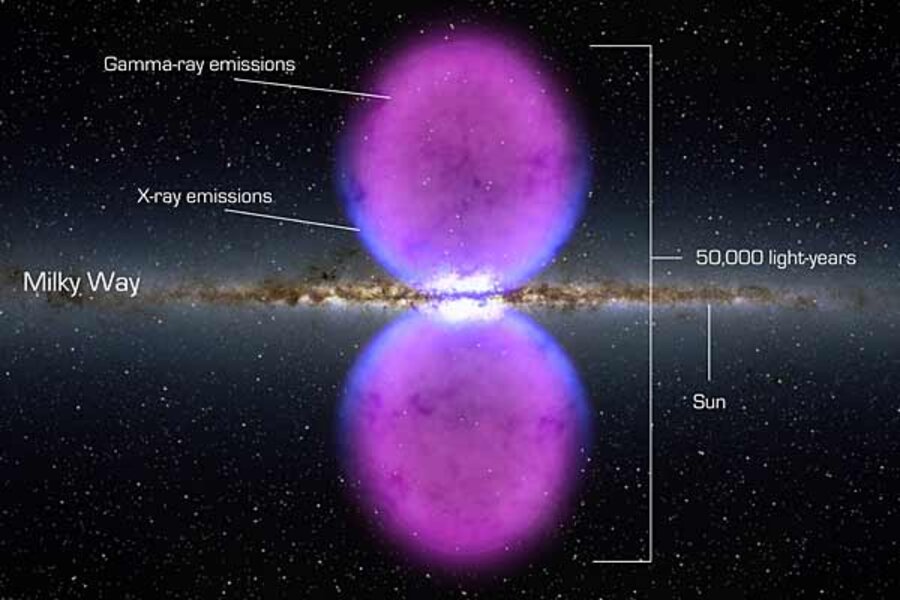Milky Way 'bubbles' baffle astronomers searching for dark matter
Loading...
Who says the Milky Way doesn't know how to party?
Scientists say they have discovered two gigantic, mysterious bubbles emerging like party balloons above and below the core of the Milky Way.
The bubbles are expanding into intergalactic space at more than 2.2 million miles an hour. Each extends some 25,000 light-years beyond the galaxy's nucleus.
Astrophysicists with the Harvard-Smithsonian Center for Astrophysics in Cambridge, Mass., discovered the bubbles using NASA's Fermi Gamma-Ray Space Telescope, currently on orbit. Gamma rays represent the most energetic form of radiation along the electromagnetic spectrum, which also includes radio waves as well as visible light.
For the moment, the discovery marks a "Hey, Martha!" moment in the annals of astrophysics. Researchers don't know why the bubbles are there. Nor have they identified the violent processes involved in generating the gamma rays that betray the bubbles' presence.
"I like the Isaac Asimov quote that discoveries don't start with: Eureka! I've found it! They start with: That looks funny!" says Douglas Bookbeiner, who led the effort.
Indeed, a galaxy blowing bubbles at temperatures of around 7 million degrees Fahrenheit was not what the team had in mind when it set out taking gamma-ray measurements of the galaxy's center, Dr. Bookbeiner says.
The team initially was hunting for evidence of dark matter at the galaxy's core.
Dark matter refers to a form of matter that is thought to make up about 80 percent of all the matter in the universe. But so far it has defied efforts to observe it; it doesn't give off or scatter light.
Astronomers infer its presence by its gravitational effects on matter they can see. The theory is that where dark matter is at its most dense, its particles and mirror-opposite anti-particles will frequently collide, annihilate each other, and give off a burst of gamma rays.
Models suggest that the best place to look for this activity is in the centers of galaxies, where the density of ordinary and dark matter is greatest.
Bookbeiner says the project his team undertook was triggered by subtle signs that might betray dark matter, found in microwave radiation coming from the galactic core.
Models predicted that a fuzzy fog of gamma rays surrounding the Milky Way's center would be the tip-off to dark matter's presence.
"To our surprise, we saw this big dumbbell-shaped feature that we've called the Fermi bubbles," he says. Far from fuzzy, the features have sharp boundaries.
As the team reviewed observations of the galaxy's center that other teams made at longer, lower-energy wavelengths, they uncovered what appears to be an onion-like layering to the features – much of the gamma-ray bubbles appear sheathed in x-rays, with a diffuse microwave haze at the base of each bubble.
These other unexplained features likely share a common origin with the bubbles, the team posits.
One possible source is the super-massive black hole at the galaxy's center. All galaxies are thought to host them. Some are more active than others – constantly vacuuming up stars, dust, and gas near the galaxy's center in a violent process that sends jets of charged particles vaulting at nearly the speed of light like beacons into space from each galactic pole.
The Fermi bubbles could be the echo of an outburst of such activity that ended perhaps a million years ago – packing enough punch to give the bubbles their crisp edges.
An alternative: the galactic center, rich in gas and new stars, underwent a burst of star formation. Between large numbers of hot young stars giving off streams of charged particles in what's called stellar wind, and the explosive ends they meet as supernovae, the winds and explosions also could have provided the energy behind the Fermi bubbles.
"In other galaxies, we see that star bursts can drive enormous gas outflows," notes David Spergel, a Princeton University researcher and member of the team making the discovery.
Still, no one has seen anything quite like the Fermi bubbles, the researchers say. Other galaxies are too far away and their centers too small, and any bubble-like gamma-ray signatures too faint to be detected by telescopes lofted into orbit so far.
Ironically, while one could posit that the gamma-ray bubbles the team detected in fact signal the presence of dark matter, the bubbles appear to complicate the dark-matter search, Bookbeiner says.
"I don't think this is dark matter. In fact, it makes it harder to find dark matter, because now we have this other thing in the way. It just confuses everything," he says.





